Research on Hollow Village Governance Based on Action Network: Mode, Mechanism and Countermeasures—Comparison of Different Patterns in Plain Agricultural Areas of China
Abstract
:1. Introduction
2. Theory and Methods
2.1. Research Ideas
2.2. Actor-Network Theory
2.2.1. The Composition of the Actor–Network of Hollow Village Governance
2.2.2. Hollow Village Governance Process based on Actor-Network
2.3. The Recognition Method of Hollow Villages Mode
3. Research Area and Data Source
3.1. Overview of the Research Area
3.2. Data Source
4. Results and Analysis
4.1. Mode Performance
4.2. Mechanism of Modes
4.2.1. Operating Mechanism of Relocation and Merger–Urban–Rural Integration Mode
4.2.2. Operating Mechanism of Village Integration–Scale Operation Mode
4.2.3. Operating Mechanism of Village Intensive–Idle Land Revitalization Mode
4.2.4. Operating Mechanism of Original Site Optimization–Sightseeing Tourism Development Mode
4.3. Policy Implications
5. Discussion
5.1. Hollow Village Governance Mechanism
5.2. Different Hollow Village Governance Mode Applicable Conditions
5.3. Insufficient Research and Prospects
6. Conclusions
- (1)
- In the case of the hollow village governance model, Fangsijie village adopts the relocation and merger–urban–rural integration mode with the hollow village governance group as the key actor, and the core is concentrated on relocation to urban communities to solve the matching problem of non-agricultural employment and living space of farmers, and to realize the urbanization of living and employment; Xingdian village takes the Fangsi Town government as the key actor of the village integration–scale operation mode and the core realization of large-scale management, centralized living, agricultural modernization and intensive land, and the centralized construction of a large-scale community agricultural park; Zhengniu village adopts the village intensive–idle land revitalization mode with the two committees of the village as the key actors, focusing on the intensive utilization of rural idle land and the development of the planting industry; Weizhuang village adopts the original site optimization–sightseeing tourism development mode with the Fangsi Town government as the key actor. The core aim is to use irrigation and transportation advantages to develop the planting industry, tap resource potential and landscape value and develop ecological tourism. Four cases of hollow village governance have achieved good results; the governance work carried out is orderly, but there are also some problems to be improved.
- (2)
- The hollow village governance mode based on the actor–network theory includes five aspects: key actors, governance subject, governance object, transfer, and identity transformation. In essence, the process of hollow village governance can be regarded as an actor–network space, which is dominated by key actors and promoted by various networks. In the process of governance, the organization mode and action mechanism of the governance subject act on the governance object and the network of actors is dynamically adjusted, which is manifested as the influence of the entry, exit, and role change of heterogeneous actors on the network relationship; this leads to the transformation of rural production and living space and realizes the transformation from hollow village to solid village. At the same time, due to differences in natural resource endowment, development degree, and development goals, as well as the influencing factors and governance requirements of the formation process of hollow villages, there are differences in the governance mode and operation process of hollow villages with different governance types and different development types under the same category. Relocation and merger–urban–rural integration mode applies to suburban villages with low dependence on agricultural income; village integration–scale operation mode is applicable to villages far from town, high village aggregation, production, and living layout confusion; village intensive–idle land revitalization mode is suitable for villages with good production and living functions and high dependence on agricultural income; the original site optimization–sightseeing tourism development mode is suitable for the villages with excellent tourism resources and convenient transportation. Within the general scope of towns in plain agricultural areas of China, the natural and geographical conditions of the same type of villages are basically the same. The favorable conditions derived from urban and rural development in the process of urbanization provide the necessity and possibility for the governance of hollow villages. The morphological representation of the governance object of hollow villages provides the basis for their classified governance. The four governance models provide experience for the precise governance of similar hollow villages in plain agricultural areas of China and the governance mechanism of hollow villages revealed in this study can be used for reference. This provides practical governance ideas for policymakers and key actors when making governance decisions.
Author Contributions
Funding
Institutional Review Board Statement
Informed Consent Statement
Conflicts of Interest
References
- Hu, S.; Liu, Y.; Xu, K. Hollow Villages and Rural Restructuring in Major Rural Regions of China: A Case Study of Yucheng City, Shandong Province. Chin. Geogr. Sci. 2011, 21, 354–363. [Google Scholar] [CrossRef]
- Lange, A.; Piorr, A.; Siebert, R.; Ingo, Z. Spatial differentiation of farm diversification: How rural attractiveness and vicinity to cities determine farm households’ response to the CAP. Land Use Policy 2013, 31, 136–144. [Google Scholar] [CrossRef]
- Posthumus, H.; Morris, J. Implications of CAP reform for land management and runoff control in England and Wales. Land Use Policy 2010, 1, 42–50. [Google Scholar] [CrossRef]
- Noble, V. Mobilities of the One-Product policy from Japan to Thailand: A critical policy study of OVOP and OTOP. Territ. Politic. Gov. 2019, 4, 455–473. [Google Scholar] [CrossRef]
- Dormael, M.V.; Dugas, S.M.; Diarra, S. North-South exchange and professional development: Experience from Mali and France. Fam. Pract. 2007, 24, 102–107. [Google Scholar] [CrossRef] [PubMed] [Green Version]
- Liu, Y.; Yan, B.; Wang, Y.F. Urban-rural development problems and transformation counter measures in the new period in China. J. Econ. Geogr. 2016, 36, 1–8. [Google Scholar] [CrossRef]
- Zheng, X.; Liu, Y. Connotation, formation mechanism and regulation strategies of rural disease in the new epoch in China. Hum. Geogr. 2018, 33, 100–106. [Google Scholar] [CrossRef]
- Ma, L.; Long, H.; Tu, S.; Zhang, Y. Characteristics of change and vitalization pathways of poor villages based on multifunctional rural development theory:A case study of Zahan Village in Hainan Province. Prog. Geogr. 2019, 38, 1435–1446. [Google Scholar] [CrossRef]
- Liu, C.; Xu, M. Characteristics and Influencing Factors on the Hollowing of Traditional Villages-Taking 2645 Villages from the Chinese Traditional Village Catalogue (Batch 5) as an Example. Int. J. Environ. Res. Public Health 2022, 23, 12759. [Google Scholar] [CrossRef]
- Gao, Y.; Ma, Y. What is absent from the current monitoring: Idleness of rural industrial land in suburban Shanghai. Habitat. Int. 2015, 49, 138–147. [Google Scholar] [CrossRef]
- Wang, D.; Zhu, Y.; Zhao, M.; Lv, Q. Multi-dimensional hollowing characteristics of traditional villages and its influence mechanism based on the micro-scale: A case study of Dongcun Village in Suzhou, China. Land Use Policy 2021, 101, 105146. [Google Scholar] [CrossRef]
- Gao, W.; Timo, D.; Zhao, Q. Understanding rural resettlement paths under the increasing versus decreasing balance land use policy in China. Land Use Policy 2021, 103, 105325. [Google Scholar] [CrossRef]
- Zhang, R.; Jiang, G.; Zhang, Q. Does urbanization always lead to rural hollowing? Assessing the spatio-temporal variations in this relationship at the county level in China 2000–2015. J. Clean. Prod. 2019, 220, 9–22. [Google Scholar] [CrossRef]
- Long, H.; Li, Y.; Liu, Y.; Michael, W.; Zou, J. Accelerated restructuring in rural China fueled by ‘increasing vs. decreasing balance’ land-use policy for dealing with hollowed villages. Land Use Policy 2012, 1, 11–22. [Google Scholar] [CrossRef]
- Cao, W.; Zhou, S.; Zhou, M. Operational Pattern of Urban-Rural Integration Regulated by Land Use in Metropolitan Fringe of China. Land 2021, 5, 515. [Google Scholar] [CrossRef]
- Wu, Y.; Zhou, Y.; Liu, Y. Exploring the outflow of population from poor areas and its main influencing factors. Habitat. Int. 2020, 99, 102161. [Google Scholar] [CrossRef]
- Liu, Y.; Liu, Y. Progress and prospect on the study of rural hollowing in China. J. Geogr. Res. 2010, 29, 35–42. [Google Scholar]
- Zheng, D.; Wen, Q.; Wang, Y.; Mi, H. Differentiation Mechanism and Reconstruction Strategy of Rural Population Hollowing in China. Econ. Geogr. 2019, 39, 161–168. [Google Scholar] [CrossRef]
- Zhang, T.; Wang, Y.; Liu, Y.; Zhao, M. Establishing an economic insurance system under a multiple dynamic evolution mechanism after rural hollowing renovation. Resour. Sci. 2016, 38, 799–813. [Google Scholar]
- Qu, Y.; Jiang, G.; Shang, R.; Gao, Y. Typical Village Domain Models of Rural Residential Land Consolidation Based on the External and Internal Characteristics of the Complex System. Acta Sci. Nat. Univ. Pekin. 2017, 53, 475–486. [Google Scholar] [CrossRef]
- Liu, Y.; Shu, L.; Peng, L. The Hollowing Process of Rural Communities in China: Considering the Regional Characteristic. Land 2021, 9, 911. [Google Scholar] [CrossRef]
- Li, J.; Liu, Y.; Yang, Y.; Jiang, N. County-rural revitalization spatial differences and model optimization in Miyun District of Beijing-Tianjin-Hebei region. J. Rural Stud. 2021, 86, 724–734. [Google Scholar] [CrossRef]
- Qiao, L. Connotation reconstruction and system characteristics of rural land consolidation from perspective of rural revitalization. Trans. Chin. Soc. Agric. Eng. 2019, 35, 58–65. [Google Scholar]
- Kong, X.; Liu, Y.; Jiang, P.; Tian, Y.; Zou, Y. A novel framework for rural homestead land transfer under collective ownership in China. Land Use Policy 2018, 78, 138–146. [Google Scholar] [CrossRef]
- Yang, R.; Xu, Q.; Long, H. Spatial distribution characteristics and optimized reconstruction analysis of China’s rural settlements during the process of rapid urbanization. J. Rural Stud. 2016, 47, 413–424. [Google Scholar] [CrossRef]
- Liu, Y.; Yang, R.; Li, Y. Potential of land consolidation of hollowed villages under different urbanization scenarios in China. J. Geogr. Sci. 2013, 3, 503–512. [Google Scholar] [CrossRef]
- Li, C.; Wu, K. Driving forces of the villages hollowing based on geographically weighted regression model: A case study of Longde County, the Ningxia Hui Autonomous Region, China. Nat. Hazards 2017, 3, 1059–1079. [Google Scholar] [CrossRef]
- Jia, L.; Zheng, X.; Xie, Y.; Li, H.; Wu, X. Study on the regulation effect and difference of the construction land of the hollow village in the suburban area of the town—A case study of 11 villages of Ranyi town. Chin. J. Agric. Resour. Reg. Plan. 2017, 38, 154–161. [Google Scholar]
- Tong, W.; Lo, K.; Zhang, P. Land Consolidation in Rural China: Life Satisfaction among Resettlers and Its Determinants. Land 2020, 4, 118. [Google Scholar] [CrossRef] [Green Version]
- Liu, R.; Yu, C.; Jiang, J.; Huang, Z.; Jiang, Y. Farmer differentiation, generational differences and farmers’ behaviors to withdraw from rural homesteads: Evidence from Chengdu, China. Habitat. Int 2020, 4, 102231. [Google Scholar] [CrossRef]
- Zhang, X.; Vies, D.; Timo, W.; Li, G.; Ye, Y.; Zheng, H.; Wang, M. A behavioral analysis of farmers during land reallocation processes of land consolidation in China: Insights from Guangxi and Shandong provinces. Land Use Policy 2019, 89, 104230. [Google Scholar] [CrossRef]
- Liu, Y.S.; Liu, Y.; Chen, Y.F.; Long, H.L. The process and driving forces of rural hollowing in China under rapid urbanization. J. Geogr. Sci. 2010, 6, 876–888. [Google Scholar] [CrossRef]
- Liu, W.P.; Yang, X.Y.; Zhong, S.Q.; Sissoko, F.; Wei, C.F. Can community-based concentration revitalise the upland villages? A case comparison of two villages in Chongqing, Southwestern China. Habitat. Int. 2018, 77, 153–166. [Google Scholar] [CrossRef]
- Chen, Y.; Yang, R.; Wang, M. Development process of rural homestay tourism and spatial restructuring with the actor-network method from the perspective of shared economy: A case study of Guanhu Village in Shenzhen. Prog. Geogeaphy 2018, 37, 718–730. [Google Scholar]
- Liu, J.S.; Zhang, X.F.; Lin, J.; Li, Y.R. Beyond government-led or community-based: Exploring the governance structure and operating models for reconstructing China’s hollowed villages. J. Rural Stud. 2019. [Google Scholar] [CrossRef]
- Li, Y.; Wu, F.L. The transformation of regional governance in China: The rescaling of statehood. Prog. Plan. 2012, 2, 55–59. [Google Scholar] [CrossRef]
- Chen, P.; Zhang, M. From beautiful village to urban residents’ consumption space: Actor-network theory and the social space reconstruction of Dashiao village. Geogr. Res. 2015, 34, 1435–1446. [Google Scholar]
- Zhou, X.L.; Geoffrey, W.; Zhang, D.P.; Cheng, X.Y. Tourism and the (re)making of rural places: The cases of two Chinese villages. Tour. Manag. Perspect. 2021, 40, 100910. [Google Scholar] [CrossRef]
- Yang, R.; Xu, Q.; Zhou, J.; Chen, Y. Mechanism of Rural Space Transformation in Fengjian Acient Village of Shunde District, Foshan Based on the Actor Network. Sci. Geogr. Sin. 2018, 38, 1817–1827. [Google Scholar] [CrossRef]
- Chao, Y.; Ma, X.Y.; Gao, Y.; Laurel, J. The lost countryside: Spatial production of rural culture in Tangwan village in Shanghai. Habitat. Int. 2020, 98, 102137. [Google Scholar] [CrossRef]
- Chen, C.; Gao, J.L.; Chen, J.L. Behavioral logics of local actors enrolled in the restructuring of rural China: A case study of Haoqiao Village in northern Jiangsu. J. Rural Stud. 2019. [Google Scholar] [CrossRef]
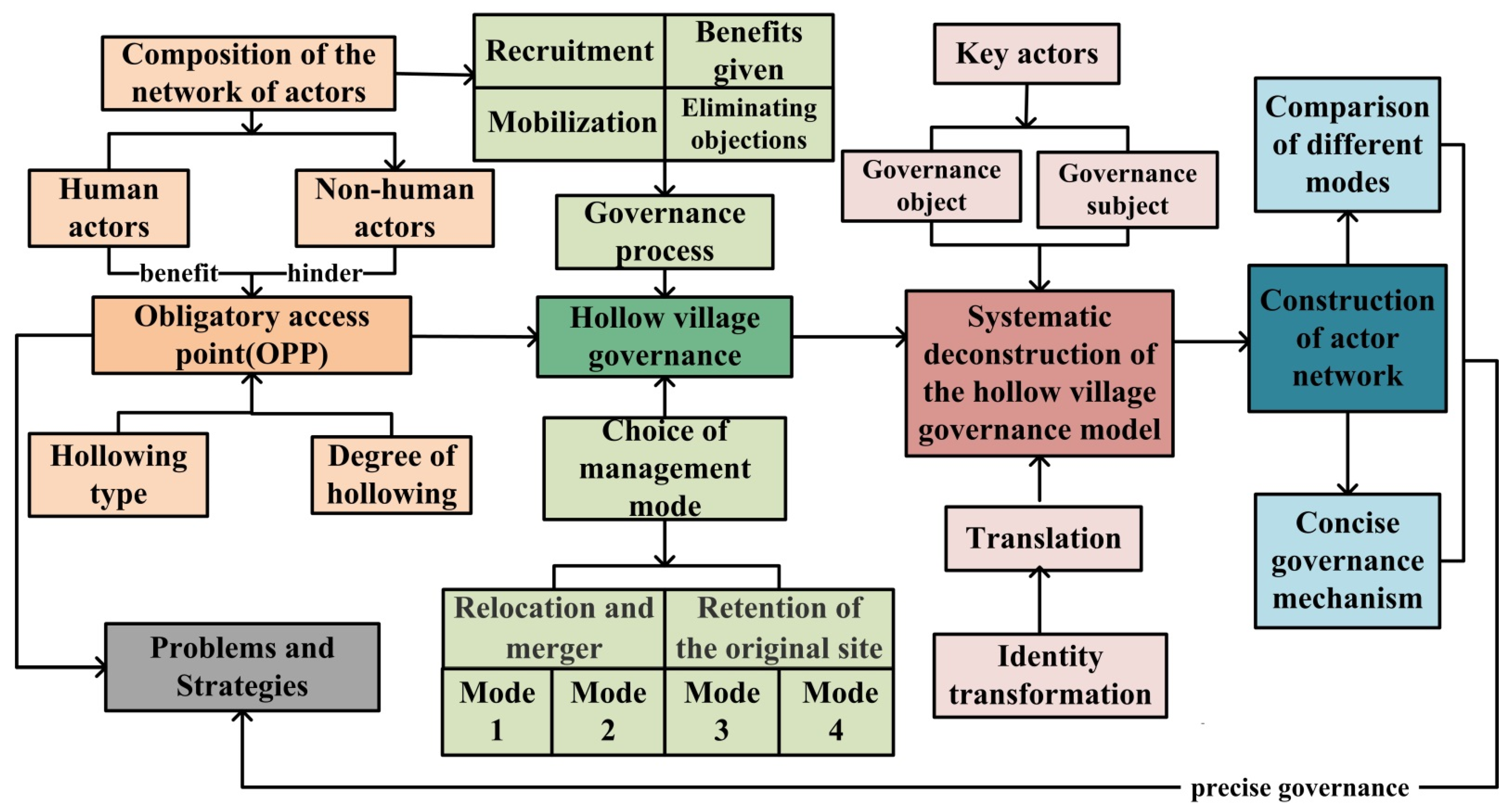

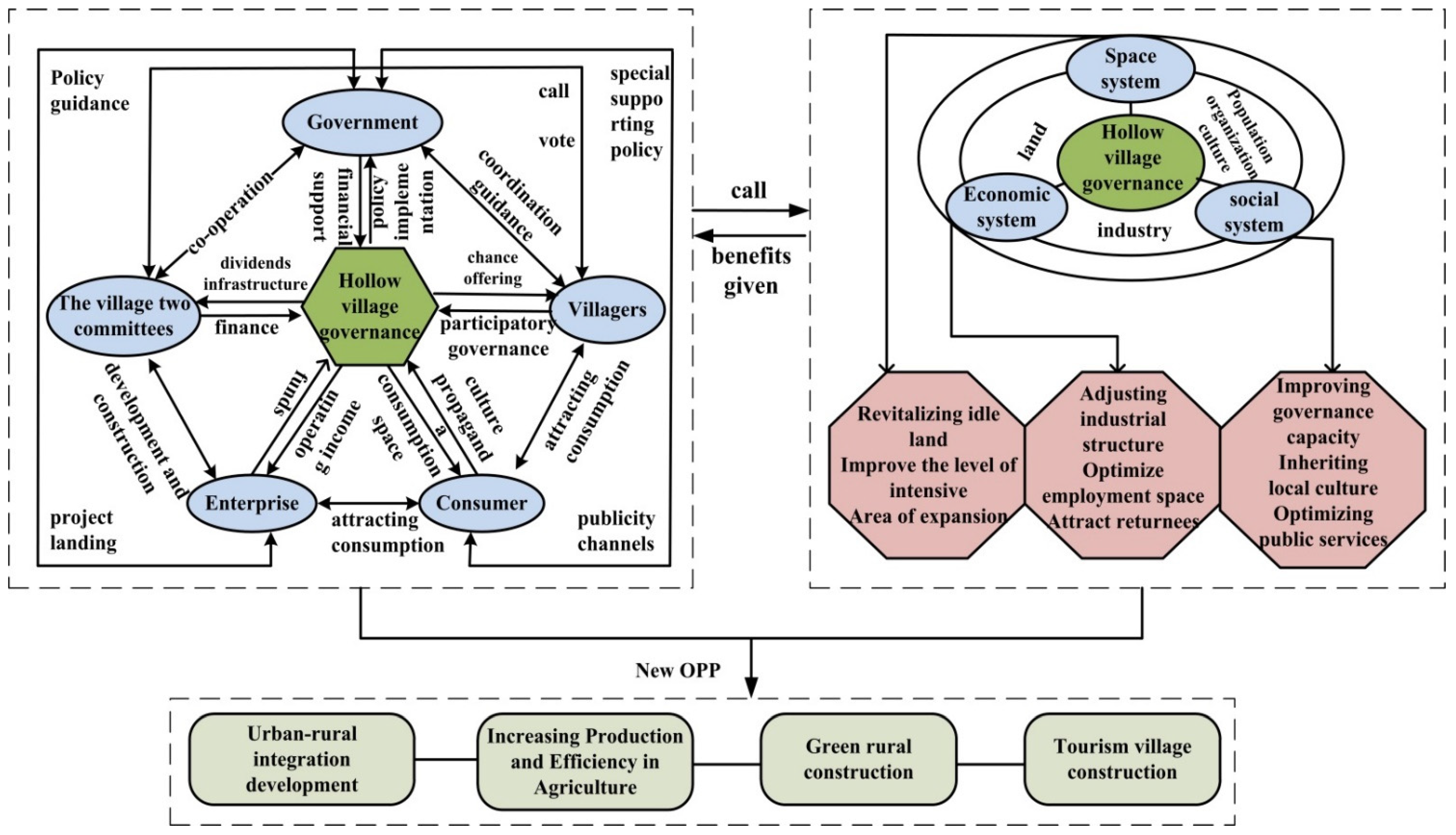

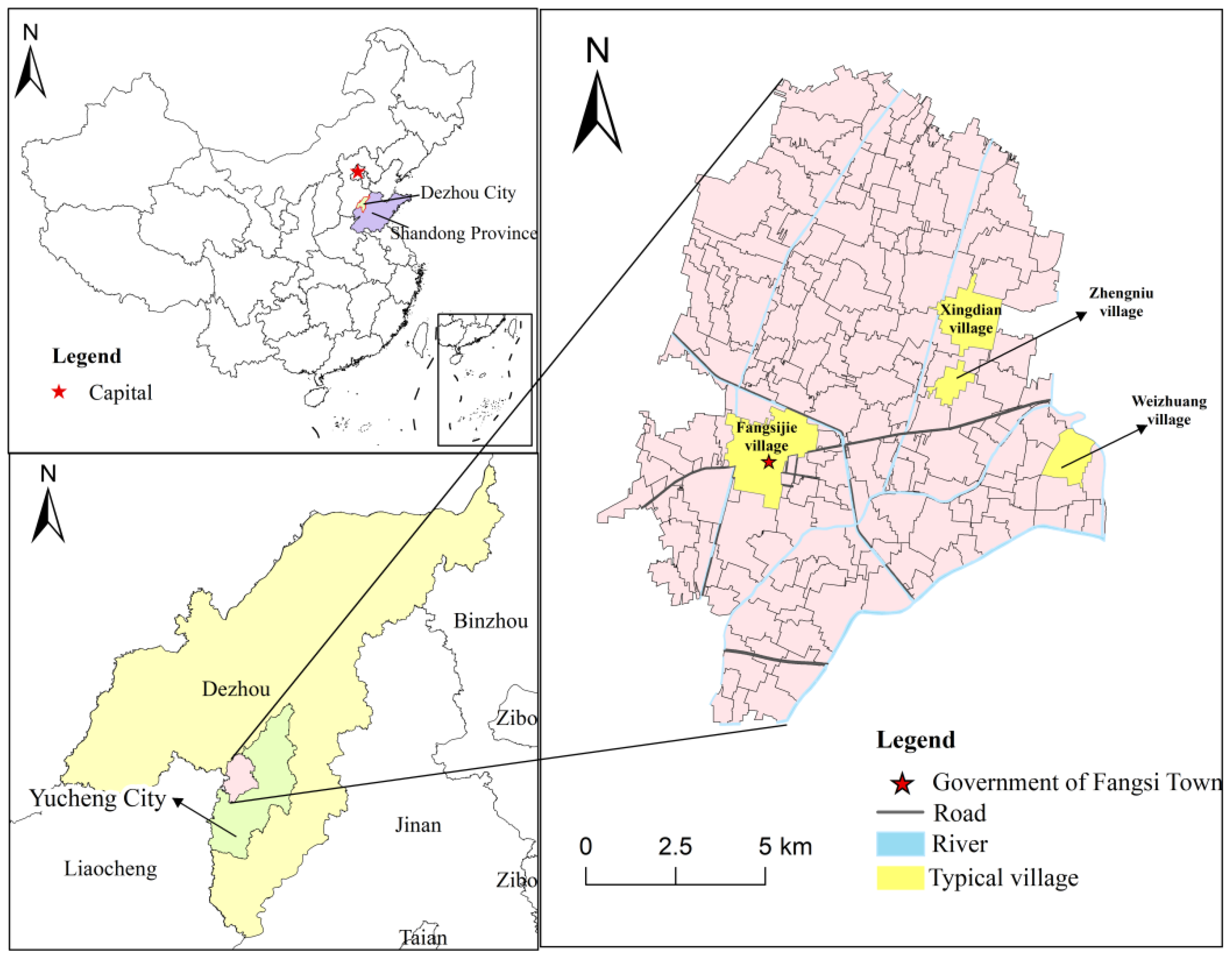
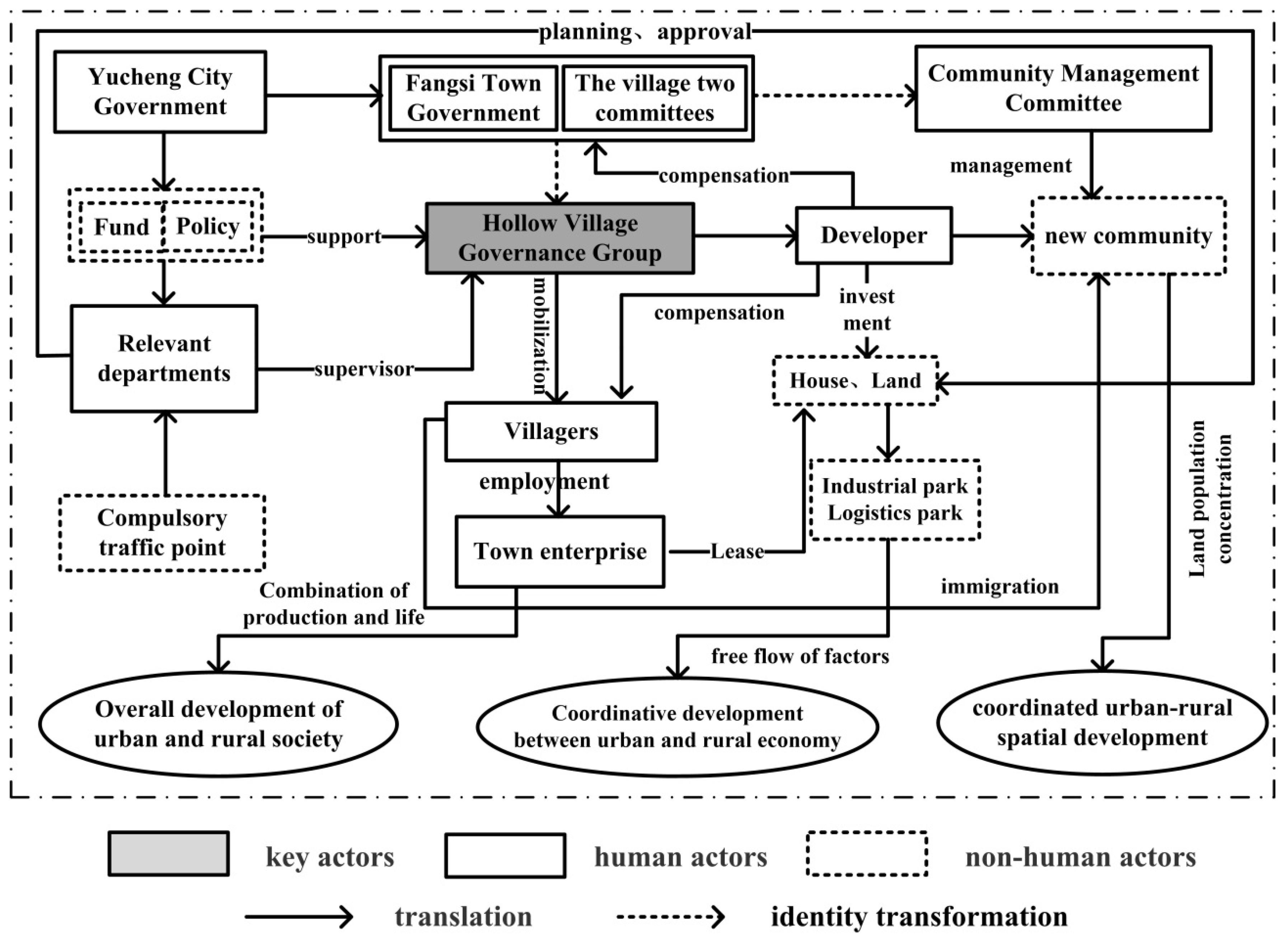
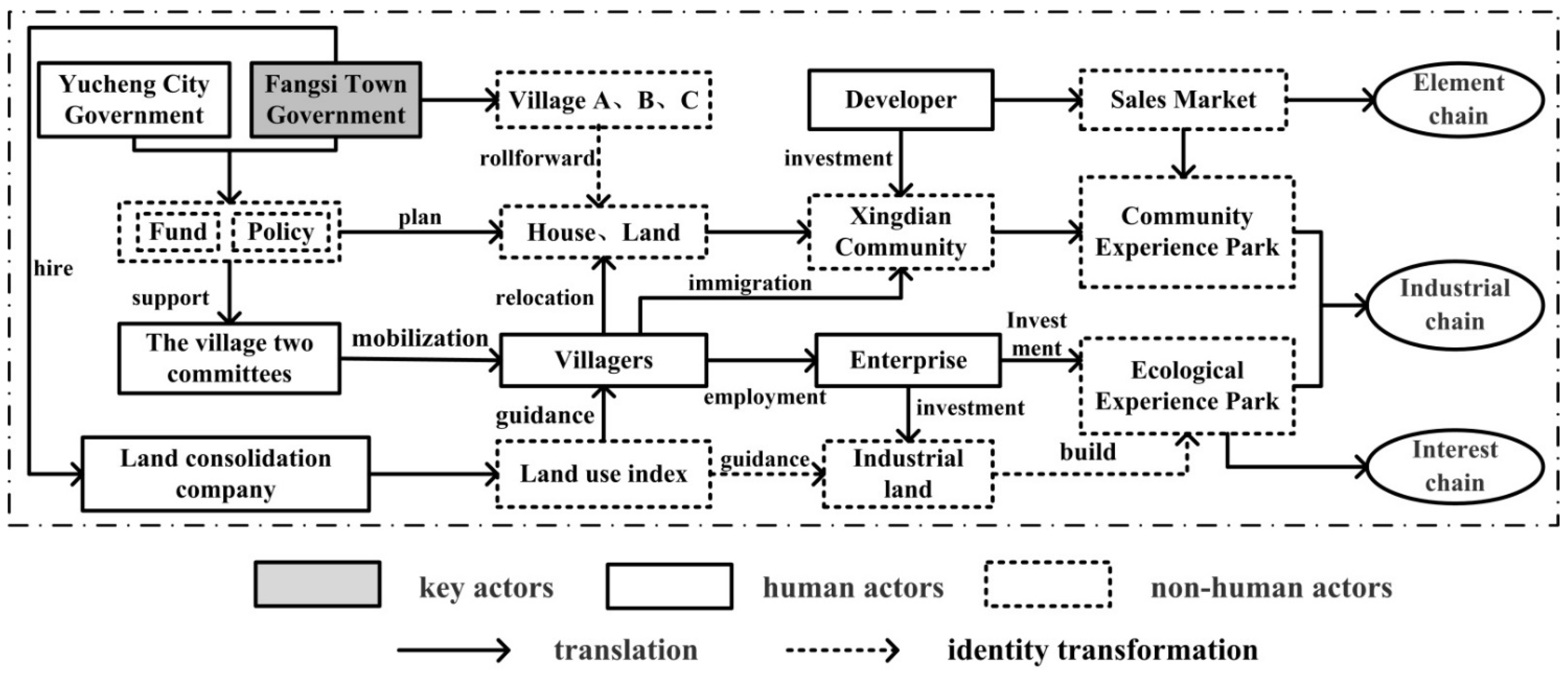
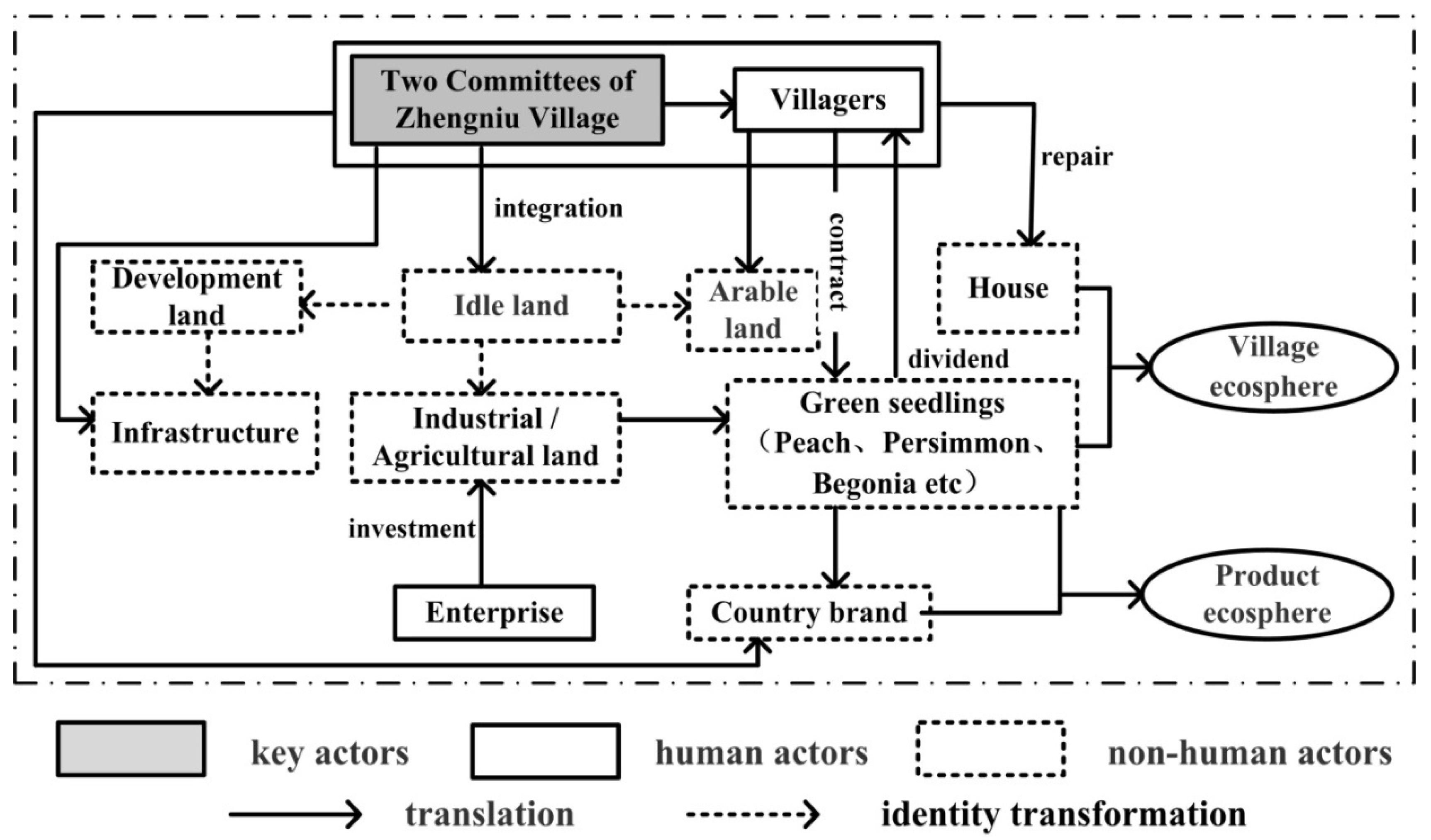
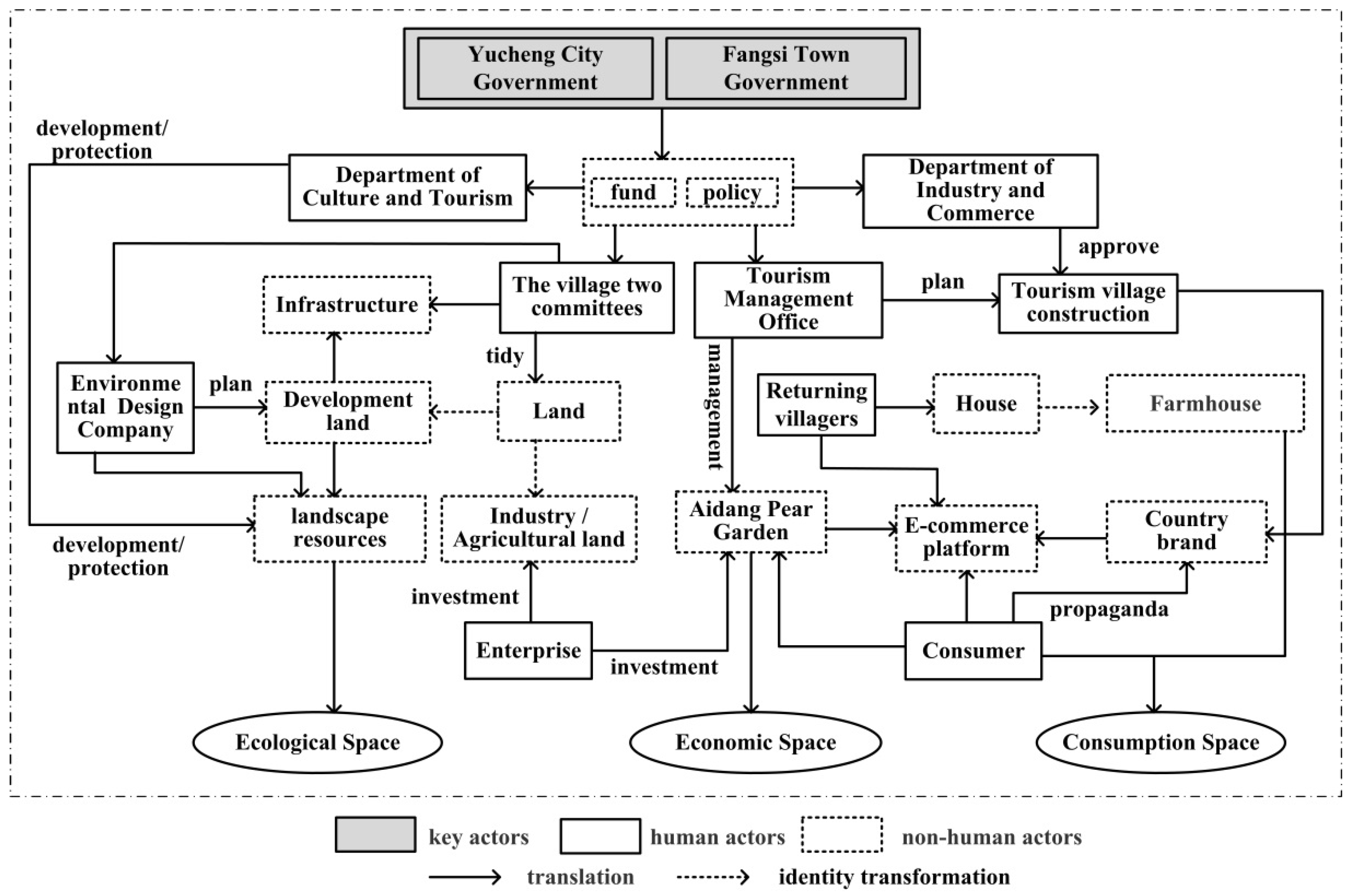
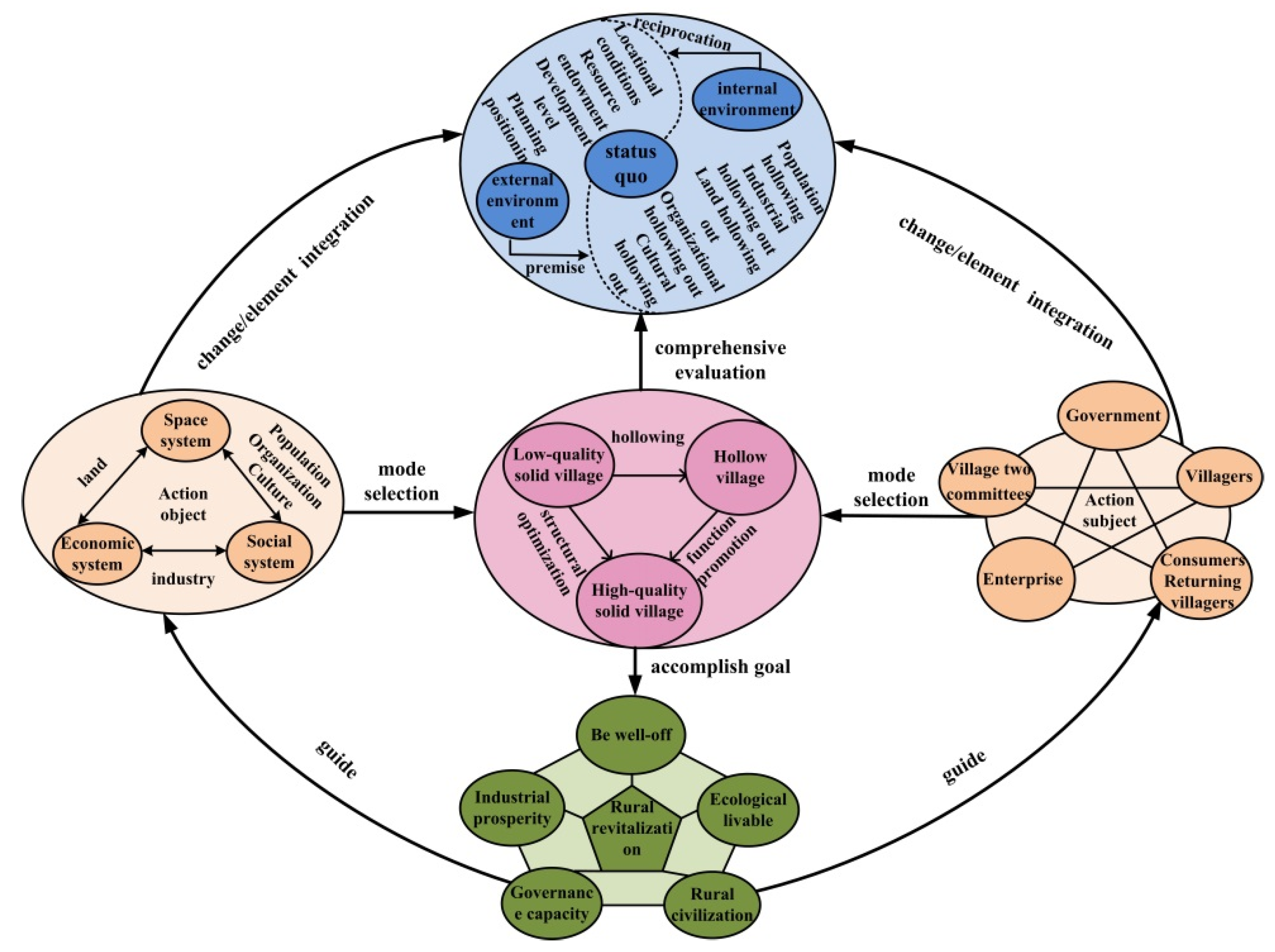
| Research Time | Interviewer | Quantity | Interview Focus |
|---|---|---|---|
| August 2020 | Town government | 2 | 1. Situation of hollow villages in towns |
| Case village two committees | 4 | 2. Hollow village governance process | |
| Case village villagers | 16 | 3. Expected development direction of hollow villages | |
| Enterprise manager | 6 | 4. The relationship between the actors | |
| tourist | 5 | 5. The role of actors in the process of hollow village governance | |
| November 2021 | Town government | 1 | 1. Status and trends in village development 2. Evolution of the relationship between actors 3. Satisfaction with village governance |
| Case village two committees | 4 | ||
| Case village villagers | 6 | ||
| Enterprise manager | 4 | ||
| Tourist | 3 |
| Mode | Case Villages | Basic Situation of Villages | Governance Content | Comparison before and after Governance |
|---|---|---|---|---|
| 1 | Fangsijie village | Located around the town, the degree of hollowing is low, as a single form of leading hollow village, farmers on agricultural income dependence are not strong, more migrant workers, the village guards weakened seriously, the villagers have a strong desire for village governance and urbanization. | The key actors of village governance are the hollow village governance group composed of the government and the village collective. The core of governance is to centralize the relocation to urban communities, transfer the village land after integration, innovate the urban–rural overall allocation and the flow mechanism of production factors, and realize the urbanization of housing and employment. |  Before  After |
| 2 | Xingdian village | Far from the urban center, the village has a high degree of aggregation and a low degree of hollowing out, which is a dual-form compound. The village land idle area is large, the village infrastructure is not perfect, farmers use farming as the main source of income, can accept a larger farming radius and intentionally improve the current living environment. | The key actor of village governance is the town government. The core of governance is to realize the scale of the operation, the centralization of living, the modernization of agriculture, and the intensification of land. The nearby villages are moved to the community, the original village land is reclaimed, and the large-scale community agricultural park is constructed. |  Before 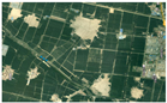 After |
| 3 | Zhengniu village | Stay away from the central town and plan to remain a governance village. The degree of hollowing out is on the verge of moderate, belonging to the dual form compound hollow village. The village has extensive land use, poor infrastructure conditions, and farmers’ migrant work and farming are the main sources of income. The seasonal idle homestead is obvious. | Villagers are the key actors in village governance. The core of governance is the intensive use of idle land such as rural corners and ponds, the planning of village boundaries, the restriction of disorderly expansion, the encouragement of villagers to withdraw more homesteads, and the use of corners to supplement village greening, infrastructure, and the development of the planting industry. |  Before 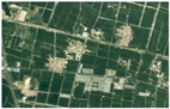 After |
| 4 | Weizhuang village | The south is adjacent to Tuhai River and the west is adjacent to Ruyi Lake Reservoir. The degree of hollowing is low, and it is a double-form compound hollow village. Villagers work outside and perform traditional agriculture for a living—there is extensive land use and the supporting facilities are not perfect. | The key actor of village governance is the government. The core is to use irrigation and transportation advantages to develop planting industry, establish cooperatives and planting bases and focus on all aspects of the village, tap the landscape potential, and develop ecological tourism. |  Before  After |
| Mode | Spatial Features | Drive Mechanism | Target | Key Actors | Operating Features | Appropriate Types |
|---|---|---|---|---|---|---|
| 1 | Relocation and withdrawal | Foreign aid | Suburban integration and overall development | Town Government and Village Committees | Interest coordination among multiple subjects | Villagers are less dependent on agricultural income in suburban towns |
| 2 | Relocation and withdrawal | Foreign aid | Residential concentration, land concentration, large-scale operation | Town government | High administrative dependence and industrial chain construction mechanism | Far from town, village gathering high, production and living layout chaos |
| 3 | Original site reservation | Inside core | Improving land use efficiency and developing collective economy | The village two committees | Flexible forms, strong participation of villagers | Production and living function foundation is good, villagers to agricultural income dependence degree is high |
| 4 | Original site reservation | Inside core | Building rural brand by traveling agriculture | Local and town governments | High dependence on enterprises and strong consumption characteristics | Good tourism resources and convenient transportation |
Publisher’s Note: MDPI stays neutral with regard to jurisdictional claims in published maps and institutional affiliations. |
© 2022 by the authors. Licensee MDPI, Basel, Switzerland. This article is an open access article distributed under the terms and conditions of the Creative Commons Attribution (CC BY) license (https://creativecommons.org/licenses/by/4.0/).
Share and Cite
Qu, Y.; Zhao, W.; Zhao, L.; Zheng, Y.; Xu, Z.; Jiang, H. Research on Hollow Village Governance Based on Action Network: Mode, Mechanism and Countermeasures—Comparison of Different Patterns in Plain Agricultural Areas of China. Land 2022, 11, 792. https://doi.org/10.3390/land11060792
Qu Y, Zhao W, Zhao L, Zheng Y, Xu Z, Jiang H. Research on Hollow Village Governance Based on Action Network: Mode, Mechanism and Countermeasures—Comparison of Different Patterns in Plain Agricultural Areas of China. Land. 2022; 11(6):792. https://doi.org/10.3390/land11060792
Chicago/Turabian StyleQu, Yanbo, Weiying Zhao, Lijun Zhao, Yanfeng Zheng, Zhiwei Xu, and Huailong Jiang. 2022. "Research on Hollow Village Governance Based on Action Network: Mode, Mechanism and Countermeasures—Comparison of Different Patterns in Plain Agricultural Areas of China" Land 11, no. 6: 792. https://doi.org/10.3390/land11060792
APA StyleQu, Y., Zhao, W., Zhao, L., Zheng, Y., Xu, Z., & Jiang, H. (2022). Research on Hollow Village Governance Based on Action Network: Mode, Mechanism and Countermeasures—Comparison of Different Patterns in Plain Agricultural Areas of China. Land, 11(6), 792. https://doi.org/10.3390/land11060792






